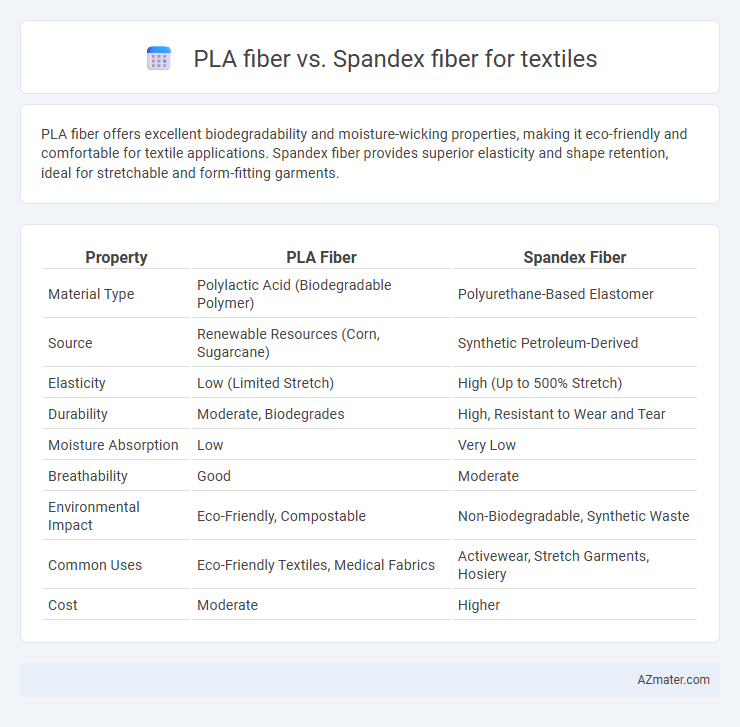PLA fiber offers excellent biodegradability and moisture-wicking properties, making it eco-friendly and comfortable for textile applications. Spandex fiber provides superior elasticity and shape retention, ideal for stretchable and form-fitting garments.
Table of Comparison
| Property | PLA Fiber | Spandex Fiber |
|---|---|---|
| Material Type | Polylactic Acid (Biodegradable Polymer) | Polyurethane-Based Elastomer |
| Source | Renewable Resources (Corn, Sugarcane) | Synthetic Petroleum-Derived |
| Elasticity | Low (Limited Stretch) | High (Up to 500% Stretch) |
| Durability | Moderate, Biodegrades | High, Resistant to Wear and Tear |
| Moisture Absorption | Low | Very Low |
| Breathability | Good | Moderate |
| Environmental Impact | Eco-Friendly, Compostable | Non-Biodegradable, Synthetic Waste |
| Common Uses | Eco-Friendly Textiles, Medical Fabrics | Activewear, Stretch Garments, Hosiery |
| Cost | Moderate | Higher |
Introduction to PLA Fiber and Spandex Fiber
PLA fiber, derived from renewable resources like cornstarch, offers biodegradability and eco-friendly properties, making it an innovative choice for sustainable textiles. Spandex fiber, known for its exceptional elasticity and durability, is widely used in activewear and stretch fabrics due to its ability to recover shape after stretching. Both fibers serve unique roles in the textile industry, with PLA emphasizing environmental benefits and Spandex prioritizing performance and comfort.
Chemical Composition and Structure Comparison
PLA fiber, derived from renewable lactic acid monomers, features a linear aliphatic polyester structure with ester linkages that provide biodegradability and good moisture absorption in textiles. Spandex fiber, composed primarily of segmented polyurethane elastomers, contains alternating soft polyether or polyester segments and hard urethane segments, granting exceptional elasticity and resilience. While PLA offers eco-friendly properties with moderate tensile strength, Spandex excels in stretchability and recovery due to its unique segmented block copolymer structure.
Sustainability and Environmental Impact
PLA fiber, derived from renewable resources like corn starch, offers significant environmental benefits due to its biodegradability and low carbon footprint compared to petroleum-based Spandex fiber. Spandex production relies heavily on fossil fuels and emits higher greenhouse gases, contributing to microplastic pollution from textile wear and washing. Choosing PLA fiber in textiles enhances sustainability by reducing reliance on non-renewable materials and minimizing long-term environmental pollution.
Mechanical Properties: Strength and Elasticity
PLA fiber exhibits high tensile strength and moderate elasticity, making it suitable for sustainable textile applications where durability is essential. Spandex fiber offers exceptional elasticity with elongation rates up to 500%, providing superior stretch and recovery for activewear and fitted garments. Comparing mechanical properties, PLA fiber is stronger but less elastic than spandex, which excels in flexibility and shape retention.
Comfort and Wearability in Textiles
PLA fiber offers excellent moisture-wicking properties and biodegradability, making it ideal for eco-friendly textiles with good breathability and comfort. Spandex fiber provides superior elasticity and shape retention, enhancing wearability by allowing greater stretch and movement without losing form. Combining PLA with spandex blends the benefits of natural comfort and flexible fit, optimizing textiles for activewear and everyday garments.
Performance in Dyeing and Finishing
PLA fiber exhibits excellent dye affinity due to its hydrophilic nature, resulting in vibrant and uniform color absorption during textile dyeing processes. Spandex fiber, known for its high elasticity, poses challenges in dyeing as it requires specialized disperse dyes and controlled temperature to maintain color fastness and fabric stretchability. In finishing, PLA fibers allow for easy application of functional coatings due to their biodegradability and surface properties, whereas spandex demands careful handling to preserve its stretch performance and avoid damage during treatments.
Moisture Management and Breathability
PLA fiber exhibits superior moisture management due to its high absorbency and natural plant-based structure, allowing efficient wicking of sweat away from the skin. Spandex fiber, while offering excellent elasticity and stretch, has limited moisture absorption and relies on blending with other fibers for enhanced breathability. In textile applications, combining PLA with spandex optimizes both comfort and performance by balancing moisture control and stretchability.
Applications in the Textile Industry
PLA fiber, derived from renewable resources like corn starch, offers biodegradability and breathability, making it ideal for eco-friendly activewear, casual clothing, and home textiles. Spandex fiber, known for its exceptional elasticity and shape retention, dominates applications requiring stretchability, such as sportswear, swimwear, and compression garments. The textile industry leverages PLA for sustainable fashion initiatives, while spandex ensures comfort and flexibility in performance-oriented apparel.
Cost and Market Availability
PLA fiber, derived from renewable resources like corn starch, typically costs more than spandex due to its biodegradable properties and emerging production scale. Spandex offers greater market availability as a widely used synthetic elastic fiber in textiles, benefiting from established manufacturing infrastructure and lower production costs. Cost-efficiency and extensive supply chains make spandex the preferred choice for stretchable fabrics, while PLA fiber is gaining niche interest for sustainable textile applications.
Future Trends and Innovations
PLA fiber, derived from renewable resources like corn starch, offers sustainable advantages and biodegradability, positioning it as a key material in the future of eco-friendly textiles. Spandex fiber remains essential for its superior elasticity and durability, driving innovations in stretchable sportswear, medical textiles, and smart fabrics with enhanced comfort and performance. Advances in bio-based PLA blends and recyclable spandex composites are shaping the next generation of high-performance, sustainable textile solutions.

Infographic: PLA fiber vs Spandex fiber for Textile
 azmater.com
azmater.com